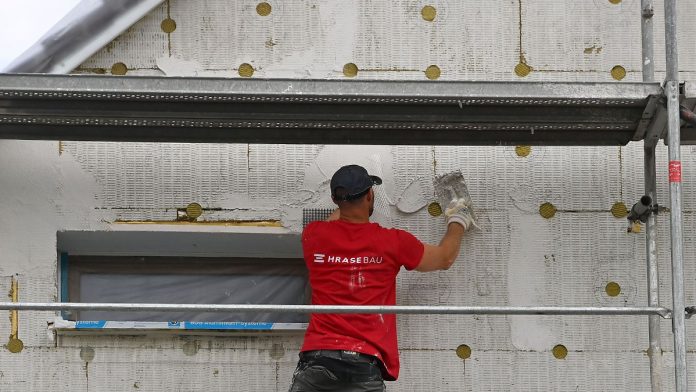Leipzig, Chemnitz and Dresden are the most energy efficient German cities. Three times East Germany, three times Saxony. This is the result of an evaluation carried out by the Federal Association for Energy-Efficient Building Envelopes (BuVEG). So can Saxony sit back and relax when it comes to the heating transition? East Germany is further than the West, says BuVEG boss Jan Peter Hinrichs in ntv's “Climate Laboratory”. But the cause dates back years: the big wave of renovations after the fall of the Wall. In fact, Germany is making little progress with energy-saving renovations. The renovation rate is heading towards zero. For Hinrichs, the last resort is a funding bonus for residents of particularly bad buildings so that they can tackle the problem on their own. Because Germany has a data problem, he says: “We don't even know which buildings we actually have.”
ntv.de: What do Leipzig, Chemnitz, Dresden or Saxony do better than the rest of Germany when it comes to energy-saving renovations?
Jan Peter Hinrichs: There is no exact answer to that because our evaluation was not a scientific one. The real estate portal Immoscout24 looked at 375,000 offers in German cities for us and checked the energy efficiency classes. The result is an indicator of what is on offer and what is not.


Jan Peter Hinrichs is managing director of the Federal Association for Energy-Efficient Building Envelopes. BuVEG is committed to “ensuring that the building shell is politically represented in Berlin”.
(Photo: BuVEG)
You have carried out the evaluation for the third time. Are East German cities always at the top?
Yes, they continue to do well, because after the fall of the Wall a lot of money was invested in renovations. This applies especially to metropolitan areas, but in rural areas it is probably the other way around.
But is it only about properties that are currently for sale or could be rented?
Exactly. Otherwise you wouldn't have access. This is a big problem in Germany: We don't even know what buildings we actually have. When it comes to apartment buildings, we have a fair idea of where they are and what they look like. When it comes to single-family homes, we know that they exist. We know roughly what their energy efficiency is, but we don't know where they are.
I'm sorry, what?
This is the usual problem: data is missing. Only buildings that are rented require an energy certificate. These are predominantly multi-family homes. In the case of single-family homes, there is usually none.
Only the residents know how good or bad the building shell is?
No, in many cases they cannot say whether they have a good or a bad building – from an energy perspective – and whether they use a lot or little gas. This has only changed since energy prices have risen. We also see this in the ministries' evaluations: the single and two-family house sector in particular has the worst energy efficiency classes. This is rarely the case with multi-family houses; the East German ones experienced at least one renovation cycle after the fall of the Wall and had a relatively good building shell.
How could one open this “black box” of single and two-family houses in the countryside? That would not be unimportant for political planning.
That would actually be very important, because you have to make an attractive offer for energy-efficient renovation, especially to people with poorer buildings. Unless you want to put the cart before the horse and say: We offer the worst buildings around 15 percent more funding. Then everyone would be interested in showing that they live in a bad building.
Would there still be time to collect the data? Or have we already reached a point in the heat transition where we should say: It doesn't matter what the existing situation looks like.
An incentive must be created to renovate. You can then send an energy consultant who will draw up a renovation plan and record the values. This opportunity should be used for data collection. Otherwise it will no longer work from a time perspective. It's not 1990, but 2024 and we have to achieve climate protection goals in six years. That's sporty.
To get back to the first question: You can't tell from the evaluation whether Leipzig, Chemnitz or Dresden have particularly good housing and building policies?
No, the evaluation has no meaning in this regard.
Can the three cities still sit back because they have already almost achieved the heating transition? Or are these the most efficient among many inefficient cities?
The energy efficiency level of the three cities is not such that we would say: That's enough. You have to move on. As mentioned, the evaluation only includes buildings that are on offer. But Saxony and East Germany are a big step further, especially when you compare them with North Rhine-Westphalia: NRW cities will be in last place for years to come.
The evaluation covers 50 cities. There are seven cities from North Rhine-Westphalia in the last ten places: Bochum, Neuss, Oberhausen, Dortmund, Hagen, Leverkusen and Solingen.
The building stock in NRW is not good. Normally there should be a wave of renovation there, like in East Germany after the fall of the Wall. There is actually a worst-performing building bonus that says: If you can prove that you have a bad building, the renovation will be particularly encouraged. But this only applies to a complete renovation. Funding was also planned for individual measures, but was not implemented.
Should we extend this bonus?
That would be an option. I would rather increase tax incentives so that you can better deduct your investments from taxes. This is already happening. With an increase, the renovation could easily be made even more attractive.
Is the falling property value not an incentive for energy-efficient renovation?
You can listen to the “Climate Laboratory” on RTL+, Amazon Music, Apple Podcasts, Spotify or via the RSS feed.
You have questions for us? Write an email to [email protected] or contact Clara Pfeffer and Christian Herrmann.
If you live in a single-family home that you don't want to sell, the property value is irrelevant. We have a portfolio of 21 million buildings in Germany, including 15 to 16 million single and two-family houses. For buildings that are not rented, property value is not a driver.
Last summer you wrote an incendiary letter to the federal government because the renovation rate at the time was less than one percent and was declining. Has the situation improved?
The renovation rate continues to decline. Most recently it was 0.72 percent. At some point the bottom is reached. If we want to meet our climate goals, we would have to achieve 1.4 to 1.6 percent, according to major studies.
Politicians didn't react to the incendiary letter?
But. There was a big construction peak where many things were put in the window. But after the Federal Constitutional Court's budget ruling, the government had other concerns and simply canceled a large part of the 14-point plan. Unfortunately, this also included improvements in renovation funding. The result can be seen in the numbers: There are hardly any applications for energy-saving renovations anymore. However, these in particular could have compensated for the sharp decline in new construction. I firmly assume that we will have serious problems throughout the construction in the summer.
Clara Pfeffer and Christian Herrmann spoke to Jan Peter Hinrichs. The conversation has been shortened and smoothed for better clarity. You can listen to the entire conversation in the “Klima-Labor” podcast.
What really helps against climate change? Climate laboratory is the ntv podcast in which Clara Pfeffer and Christian Herrmann put ideas, solutions and claims through their paces. Is Germany an electricity beggar? Is the energy transition destroying industry and jobs? Why do so many people expect their economic decline? Why are the Greens always to blame? Are sea eagles really more important than wind turbines? Can nuclear power save us?
The ntv climate laboratory: half an hour every Thursday that informs, has fun and cleans up. At ntv and everywhere there are podcasts: RTL+, Amazon Music, Apple Podcasts, Spotify, RSS feed
You have questions for us? Write an email to [email protected] or contact Clara Pfeffer and Christian Herrmann.


